 |
Microsoft Inspire 2018 kicks off at the T-Mobile Arena.
Photo courtesy of Microsoft |
| |
Organizations around the world are undergoing transformation fueled by cloud, artificial intelligence, mixed reality, and the Internet of Things.
These technologies are helping businesses and society reach new heights – retail is becoming more personal, banking is becoming more seamless, and healthcare is becoming more predictive and preventive.
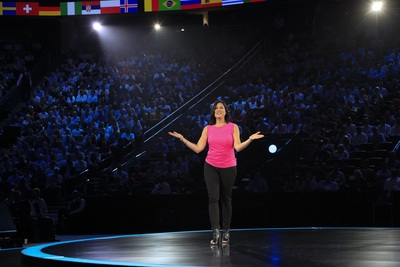 |
Gavriella Schuster, corporate vice president, Worldwide Partner Group, at Microsoft Inspire 2018.
Photo courtesy of Microsoft |
| |
At the heart of these incredible stories of transformation – and more – are Microsoft partners.
The Microsoft partner ecosystem is a group of hundreds of thousands of organizations driving positive, global impact.
Building everything from line-of-business apps to industry-specific solutions on Dynamics 365 to gaming experiences, these companies are a natural extension of the team at Microsoft, delivering cutting-edge technology to millions of customers.
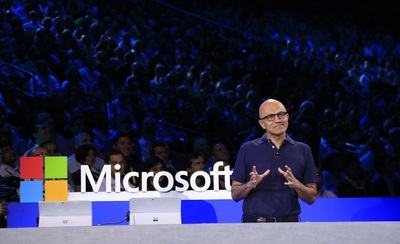 |
Chief Executive Officer Satya Nadella at Microsoft Inspire 2018.
Photo courtesy of Microsoft |
| |
Inspire Ready 2018
By Satya Nadella
July 18, 2018
SATYA NADELLA: All right. (Applause.) Thank you. Thank you. Thank you. (Applause.)
You know, growing up I always dreamt of this day. Walking up on stage on a Wednesday morning, right after 18,000 people have had a singalong -- and do a tech speech. (Laughter.) I'm going to live that dream.
Look, today is a momentous milestone for us, bringing together these two communities, Inspire and Ready, because that's how our customers see us, as one. And to be able to kick off our fiscal year is something that I think is going to really mark a real difference in how we as this tech community are going to serve our customers going forward.
There's no community like this. And I was thinking about it, the scale, and what I'm told 17 million people are employed by people in this room across the ecosystem. I mean, that's a tremendous scale. (Applause, cheers.)
We've had an amazing year. The success that this ecosystem has had is just enormous. And I first want to start by saying a big thank you, really a sincere, heartfelt thank you to each and every one of you, your organizations, your teams back home, because without that none of this would be possible. So thank you so very much.
(Applause.)
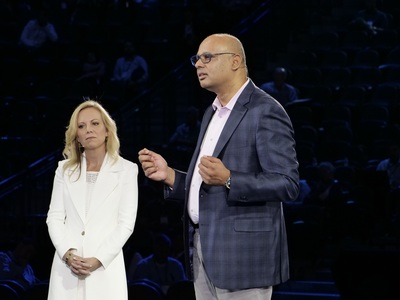 |
Alysa Taylor, corporate vice president, Business Apps and Industry Marketing (left), and Anand Eswaran, corporate vice president, Digital Services, at Microsoft Inspire 2018.
Photo courtesy of Microsoft |
| |
But what binds us together, though, is not our success, it's the success that our customers achieve, because that's what makes us as a community, as a tech ecosystem, unique, different. And to me, as we look forward, the opportunities for us to serve our customers in this new era of the intelligent cloud and the intelligent edge is far greater. I've sort of lived through the client-server, the web, mobile, cloud, but what we're going to see going forward is going to be even more profound.
And the reason for that is perhaps best captured in this quote by Mark Weiser who used to work at Xerox PARC in the late-'80s. And he said something which I think really captures what's happening in 2018: "The most profound technologies are those that disappear. They weave themselves into the fabric of everyday life until they're indistinguishable from it." That's what's happening with technology. That's what's happening with computing. Computing is becoming part of our world, of our life.
If you look at it, there's computing in every home, in every office, every stadium, every factory, every industry -- whether it's oil and gas, whether it's retail, or whether it's agriculture or financial services -- and everything, whether it's that self-driving car, it's that connected refrigerator, any engine, all of it has computing. It's just part of the fabric of life, the fabric of our society.
And you see it in the numbers, too. By the way, we are lucky to be in the tech industry. As a percentage of world GDP tech spend today is at around 5 percent. It's expected to double by 2030. Now the real question is what about the other 95 percent, that other 90 percent, because all of the COGS of the world, all of the operating expense of the world is going to be powered by digital technology. Our job is not just to celebrate our own growth, because it's going to happen, it's secular, but really to stay grounded on how are we helping the rest of the economy get the dividend because of digital technology. That's what this ecosystem's job number one, two and three is.
That also means that we have a tremendous responsibility with all this opportunity, we have to do our very best work when it comes to privacy, because as technology and digital technology becomes pervasive in our lives, we have to approach everything with the fundamental assumption that privacy is a human right. And what has --
(Applause.)
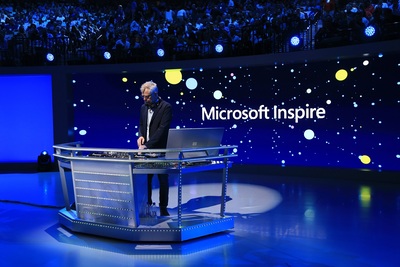 |
KEXP’s Darek Mazzone at Microsoft Inspire 2018.
Photo courtesy of Microsoft |
| |
And GDPR as a regulation is something that we've poured a lot of energy into, but it's not just a one-time thing, it's an ongoing commitment to ensure that everything we do is going to have that sense of compliance that GDPR and other regulations around the world are going to demand of us as an ecosystem.
When it comes to cybersecurity we, again, have to do our very best work, not just in the technology side, but the operational security side. But we've got to go way beyond that. We also have to come together as an industry, show real maturity in terms of the things that we come together on.
The Tech Accord is a fantastic example of that, because the world in our time needs a new Geneva Convention. We need to make sure that the most vulnerable populations are protected from these new weapons. And when it comes to AI, we have to have a set of principles that guide the development of AI. We want to make sure that anything that we do doesn't amplify bias, doesn't hijack our attention, doesn't sway opinion. These are things where we need to not only build the tools, the technologies, but it's also a set of design principles, a set of ethical principles that we as builders of technology need to have.
Now, it’s that opportunity and responsibility that grounds us in our mission, our mission to empower every person and every organization on the planet to achieve more. As I've always said, these are not just a set of words on a slide for us. This is the core guiding North Star. Everything that we do, every product we build, every technology we incubate, how we show up with our customers all has to be driven by a deep sense of everyday understanding of this mission.
I always say this to any student who is joining Microsoft or looking to join Microsoft. I say to them, look, if you want to be cool go look for someplace else. But if you want to join a company that is committed to making others cool, join Microsoft.
(Applause.)
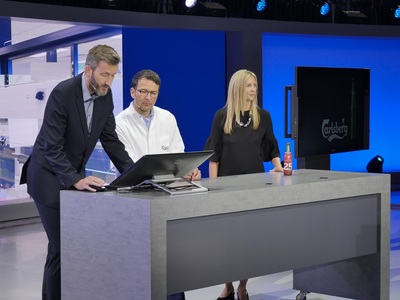 |
Carlsberg demos how AI can help with beer brewing at Microsoft Inspire 2018.
Photo courtesy of Microsoft |
| |
I believe that's what captures what each of us do. In fact, the rest of my presentation is about talking about cool people outside this room because that's what gives us meaning in our work, that's why we choose to be part of this ecosystem.
Now, of course, as we move to the intelligent cloud, intelligent era we will express how we do things very differently. You heard a lot about these six solution areas. What is common across all of these solution areas is this profound shift to a new way of doing things, the intelligent cloud, the intelligent edge and ultimately, though, we've got to measure ourselves not by technology for technology's sake, but how are we empowering people? How are we helping organizations with their digital transformational outcome? That's what this is all about.
So I want to unpack today a little more about what is this paradigm shift, how should we think about it. As I said it's probably bigger than anything that's come before. There are three things that are happening simultaneously, at the experience where we are moving to this people-centered experience. That means we are going to, in some sense, decouple the experience from the device.
We're also going to decouple the input output. That is it's going to be multi-sense multi-device. You may start on one device with one sense. In fact, the output could have another sense on another device. But it's going to be part of the same application. We are going to infuse everything with AI. It's going to have perception capability, language capability and autonomy that's going to be built into the applications going forward.
And to power all of this the one thing that's needed is a ubiquitous distributed computing fabric. And so I want to get into a little bit of each of these and see even how customers are already using it. How you all are taking advantage of this amazing opportunity to build solutions in the real world. So let's start at the bottom with ubiquitous computing.
Now, I was there in the very early days of Azure. And when I see where we are in 2018 it just boggles my mind. The scale of Azure with its 54 data center regions, as you know for each region we have multiple data centers. The amount of interconnect cable we have across Azure Data Centers is enough to go to the moon and back three times over. It’s crazy.
(Applause.)
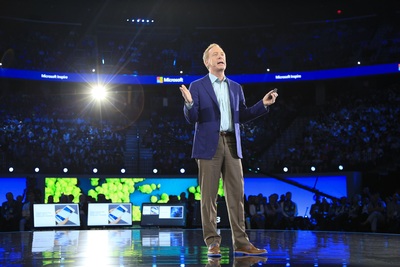 |
Brad Smith, president and chief legal officer, at Microsoft Inspire 2018.
Photo courtesy of Microsoft |
| |
We have the best compliance of any public cloud. We process millions of network transactions. So the scale is just enormous. And one of the things that we recently did is we decided that, you know what? You want to build a data center and just submerge it in the sea. So Project Natick is essentially a data center, by the way, the most interesting part of this that I love is from start to finish you can get a data center built in 90 days. That's what I love, which is the speed with which you can start provisioning data centers like you provision virtual machines.
And since 80 percent of the world's population lives around the sea coast, you can now start envisioning a world where you can start bringing compute power close to all the population centers as needed. And, by the way, what's most interesting is it's zero emissions, fully self-sufficient. And so we're very excited about pushing even what is the conventional wisdom of what is a data center. Now, of course, computing needs will go far beyond the data center.
Essentially wherever there is data, compute will migrate to data. And so we are going and taking Azure to Azure Stack, to Azure IoT Edge, to Azure Sphere. This is that one ubiquitous distributed computing fabric. One programming model that is event-driven, serverless, so you can write an application that truly works across all of this.
That I believe is the biggest unique thing that this ecosystem has as the world gets embedded with computing. Every use case out there is going to be powered by something like this. You see this in the customer momentum. The brand just this week the announcements all are reflective of how customers are really adopting.
In fact, some of the most fascinating things is the new workloads that are pulling things like Azure Stack, Azure Sphere, Azure IoT, along with some of the most sophisticated AI-powered things that are happening in the cloud. It's great to see. Walmart is using Azure, as well as Microsoft 365 and Dynamics 365. I mean as you know, Walmart, Fortune One, it's the biggest company in the world. They are innovating in retail. They have an amazing presence in offline. And they have good momentum in their online efforts with Jeff and Walmart.com.
And the interesting thing that they're trying to do is to make sure that they connect the two worlds for their customers. After all, what is every online merchant trying to do now? They're trying to build offline, whereas in the case of Walmart they're connecting the two. And the ability for this ubiquitous computing fabric to be able to take IoT sensors in refrigerators in the store and reflect inventory online and then have pickup, those are the type of scenarios that we can enable.
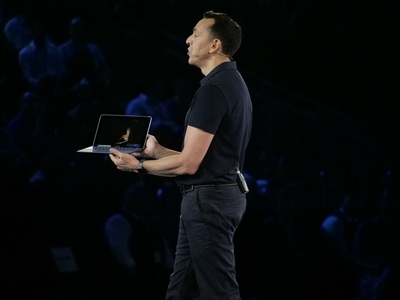 |
Yusuf Mehdi, corporate vice president, Modern Life & Devices at Microsoft Inspire 2018.
Photo courtesy of Microsoft |
| |
Vulcan Steel is a manufacturer of steel out of New Zealand and Australia. Actually, first let me talk about Chevron. Sorry, I went one step further. Chevron, their key goal is to make sure that compute is available in the remotest of locations, because if you think about an oil field the digitization of the oil rig, in fact, the drill bit itself, the feedback loop from there is now much more intense than it ever was. The manual operations has now got a digital feedback loop so that you can have accuracy and that actually has all kinds of benefits for the environment.
But that means the speed of light is a massive issue. You can't wait for the cloud rendezvous for that feedback cycle. And so they're deploying Azure Stack where they need it, where the data is being generated, where the AI needs to actually have the reasoning power.
And Vulcan Steel is in the safety business because of the material they handle, the safety of that material handling is super important to them. So what they're doing is taking just commodity cameras, putting it in their warehouses, putting it in their trucks, and putting it in containers with an AI model to do object recognition so that they can ensure safety and safety policy adherence.
Now the other piece which I'm very, very excited about is Azure Sphere. We just launched it earlier this year. It's a very innovative piece of work where we bring a silicon design that's secure by design, we bring an operating system as well as a cloud service to ensure that the 9 billion microcontrollers become Azure compute endpoints, because these 9 billion controllers are what are making things like thermostats or refrigerators or microwave ovens all connected.
The question is how are you going to make sure that these compute endpoints are secure and capable of doing sophisticated processing. And that's what Azure Sphere does, and you already see this being used across a lot of very different customers.
The last example I want to use and I want to talk about is Case Western Reserve. Case Western Reserve has always led with innovation. Last year we talked about quantum computing, and one of the things that we did is to prepare people, because the entire computer science stack of a quantum computer is going to be different. None of the things that we learned with the von Neumann machine are going to be relevant, which is sort of sad, but it's going to be true.
And so that means you've got to relearn how to think about the core algorithms. So we put a simulator up on Azure, and there was a researcher at Case Western who had done some fundamental work on how to take MRI machines and using this technique of tissue fingerprinting get much better at accurately detecting cancer right in the early stages of scanning.
One of the challenges of computing was that the lookup that you needed to do was just not possible with practical computers. So now with a quantum-inspired algorithm, we are going to see us, or Case Western Reserve in this case, change how even an MRI scan can start getting so much more efficient in being able to detect cancer early on.
So that's the type of things that with more compute, with more data and the ability to reason over this data, using the new types of algorithms can have real impact. So that's ubiquitous computing.
So I want to move to that next transition, the transition to AI. Microsoft has been working on fundamental AI breakthroughs for 20-plus years, 20-plus years ago is when Bill started Microsoft Research. And, in fact, just in the last couple of years, some of the advances, especially as measured by our ability to have human parity in a lot of these perception and language capabilities is pretty stunning. And it's happening because of the ability to provision lots of compute capability, to have lots of data, and these new techniques of algorithm promise around deep neural net in particular.
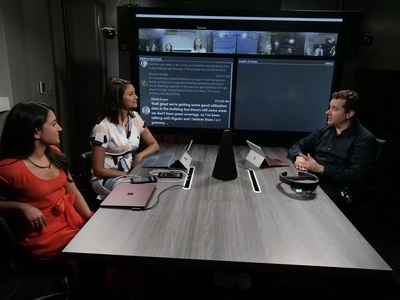 |
Clockwise from left: Raanah Amjadi, Sonia Dara and Daniel Escapa at Microsoft Inspire 2018.
Photo courtesy of Microsoft |
| |
So for example, 2016 is when, for the first time, when we were able to have human parity level object recognition with that Image Net Competition, a 152-layer deep neural net that was able to show that these neural networks were able to recognize objects like human beings. And in 2017 is when we had human parity on speech recognition using that switchboard data set that's been there for us for all time.
And just this year, earlier in January, we participated in this SQuAD Competition, which is a Stanford Q&A test for machine-reading and comprehension. So this is the ability to read a piece of text and start answering questions. I wish I had it for SAT. But that ability to be able to do machine reading and comprehension we now have human parity. And even in machine translations as late as March of this year, to be able to do translations with human parity.
These are amazing breakthroughs.
But again, going back to our mission, it's not about celebrating these breakthroughs from Microsoft Research. Our collective objective is to take these breakthroughs and democratize them with the tooling we create, with the expertise and the skill set and the skill set and the services that you provide. For us to be able to turn every industry into an AI-first industry, whether it's retail or healthcare or agriculture, we want to be able to make sure that they can take their data, in a security-privacy preserving way, convert that into AI capability that they get the return on. That's really the objective.
In fact, I want to walk through some examples of this.
Steward Healthcare is one of the largest private hospital operators in the United States, and BlueMetal, who is an AI partner of the year, really took the AI capability in Azure and applied it to perhaps what at least in the United States is a really acute challenge for us, which is healthcare costs.
 |
Jason Zander, executive vice president, Azure, at Microsoft Inspire 2018.
Photo courtesy of Microsoft |
| |
Around 18 percent of our GDP is in healthcare. And what we now need to do is to turn this around by making sure that health outcomes are getting better but the costs are coming down. And to be able to apply machine learning and to really see us make a real difference on bending that curve is what BlueMetal and Steward Healthcare are really doing.
Kroger is changing again how they think about retail experience. They're building this edge smart shelf, which changes the retail experience for anybody who walks into an offline retail store. You can essentially have a digital interface right at the shelf that they can query, ask questions from their phone, find products that they're looking for.
And of course for the retailer that means they can do real-time pricing, real-time couponing, as well as trade marketing.
So the entire, in fact, the actions, some of the most sophisticated AI technology that I see being deployed around the world is actually in offline retail.
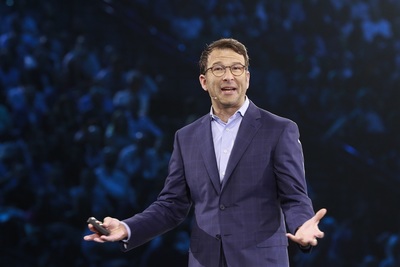 |
Judson Althoff, executive vice president, Worldwide Commercial Business, at Microsoft Inspire 2018.
Photo courtesy of Microsoft |
| |
McDonald's. In fact, a couple of years ago is when I first started showing some of the work that we were doing with McDonald's around their experimentation on drive-throughs. For them the mission-critical application is the drive-through application, the order accuracy, and using all of the ambient noise and training a model that recognizes the order is what McDonald's experimented with.
And now they have higher ambitions. They want to really do an end-to-end automation of their drive-throughs, mobile order pay. They want to be able to do delivery. And so they're using AI and working with partners and us to really drive the next breakthrough in terms of the experience of McDonald's.
Walt Disney, this is a fun one. You know, they are building as part of Walt Disney World Resorts and in Animal Kingdom they have a massive project around a connected Animal Kingdom.
But one of the things that they're doing is they have these bird cages and they have put together sensors and connectivity and cameras in these cages. And one of the things that they have really tried to do is to support conservationists who study the purple martin birds.
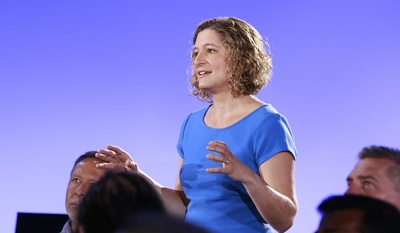 |
Lorraine Bardeen, general manager, Mixed Reality Workplace at Microsoft Inspire 2018.
Photo courtesy of Microsoft |
| |
Now, these purple martin birds, believe me, I've learned so much in the last couple of days about them, they are fascinating. One of the sad parts is that the population of these birds has reduced by something like close to 40 percent in the last 30 years or so. So they are going extinct and so conservationists are trying to study these birds and to make sure that we understand what are the things that we can do to intervene in this process.
But the entire challenge has been how do you collect the data. It's laborious, it's sporadic, and so how do you make it a continuous digital feedback loop? So that's what really was the inspiration by these connected bird cages.
And so now what they have is the ability to have AI models that help the conservationist to be able to understand exactly what we can do to preserve these birds. So it's a fantastic use case, and I think these are the kinds of things that we are seeing in many of these places where I think AI can make a real difference.
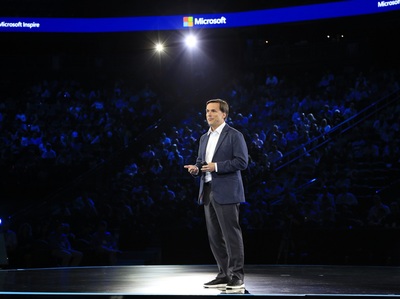 |
Ron Markezich, corporate vice president, Microsoft 365 at Microsoft Inspire 2018.
Photo courtesy of Microsoft |
| |
Now, another example of AI is autonomy. If you think about it, beyond perception, which is the ability to see, hear, and in fact, fuse these multiple sensors, the question is, can we make things more autonomous?
And Turner Material Handling, they're trying to build a warehouse which is fully autonomous. That means the pallets are taking the material and really making sure that they show up at the right place at the right time.
Now, one of the foundational challenges of autonomy is training. The training costs of trying to make anything autonomous, that means you've got to replicate essentially the real world and drive through all of this multiple times.
Now, that's a lot of cost and a lot of time. But what if you can simulate it? So essentially, that's what we are doing. We have a project called AirSim which can be used for autonomous drones, autonomous cars, it can be used for autonomous pallets, where you can literally take whatever it is that is the physical terrain through which you want autonomous movement, simulate it, and reduce the total time and cost of training.
And I think this is going to be massive breakthrough. This is really truly democratizing autonomy into a set of toolkits that everyone here can use, because autonomy is not just about some few self-driving projects, this is about autonomy everywhere.
 |
Julia White, corporate vice president, Azure at Microsoft Inspire 2018.
Photo courtesy of Microsoft |
| |
Now, the last example I want to talk about in AI is around conversations. In fact, in the last year we've seen tremendous progress in the use of some of the things that we have put together around language like the Bot Framework, LUIS, which has the Language Understanding NLU in it. We've seen people like Unilever, Telefonica, Progressive Insurance, many brands use this to build their own agent. Any consumer brand that wants to interface with their customers is going to want to build their own branded conversational interface. And we want to democratize that, we have built the toolkit for it.
One of the things that we're also doing is to try and push this concept of language understanding or this capability of language understanding to the next level, to have the ability to do full duplex conversations. So that means two people, the bot and the human being, being able to do back and forth open domain. So that is not in one domain but any domain. That's sort of in some sense an ultimate AI complete challenge.
And we've been working on this with XiaoIce in China for multiple years. XiaoIce today has -- (Cheers, applause.) So they love XiaoIce. (Laughter.) The world will love XiaoIce, too.
There's 500 million friends that XiaoIce has. It's a celebrity on TV. It's written its own book of poetry. You know, XiaoIce does a lot of things, but one of the things that we've recently started doing is these full duplex conversations.
But while we do these full duplex conversations, the thing that we are trying to make sure we learn is what's the EQ that needs to go with the IQ of AI. How do we make sure that the bot identifies itself as a bot, make sure that there is full transparency in this dialogue? How do we think about this? These are unsolved problems. Actually, the technical part probably is the easier one, but how do we interact with such social bots? That's what we are trying to learn.
To give you a flavor for something which is a full duplex conversation, I want to just play a recording. Let's play that.
(XiaoIce audio segment.)
(Applause.)
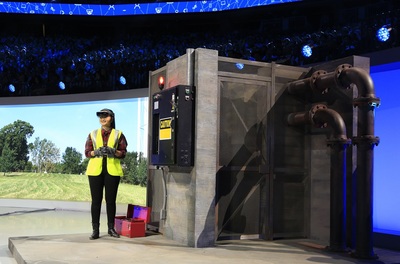 |
Mahak Mithani, program manager, at Microsoft Inspire 2018.
Photo courtesy of Microsoft |
| |
SATYA NADELLA: We're in the early days of learning how these kinds of social experiences are going to really become commonplace, but at the same time, things that are done in a way that we as humans really are at the center of it and in control.
I want to now transition to the last big shift, which is towards people-centered experiences. Fundamentally, so far, we've built applications which are what I would describe as device centric. We've really not, whether it's the operating system or the application, not broken free of the device. And that's what's going to have to happen.
That means put people at the center, the relationship people have with other people, the activities and tasks that you do. That's what's got to drive the devices in our life, not the other way around.
And to us, that's what we're trying to do across the board, whether it is in gaming, whether it's in Microsoft 365, whether it's with Dynamics 365 -- it's about building these people-centered, multi-sense, multi-device experiences.
In fact, gaming is a great example. We're learning a ton with the changes that are afoot in the gaming business -- the way the games are built, the way the games are played and where they are played and how they're watched are going through a profound shift.
Let's roll the video to give you a flavor for some of the changes that are happening in gaming.
(Video: Gaming)
(Applause.)
SATYA NADELLA: And it's pretty exciting to see how gaming is changing, and in fact, as I said, we're learning a lot from that multi-sense, multi-device experience across the console, the PC, the phone, our subscription services, the Mixer game streaming, and really thinking about what is the moral equivalent of that across all of our other services?
I want to show you my own personal use of Microsoft 365. I have multiple devices in my life, I have a Surface Studio at work and at home, in fact, Surface Go has really been a game-changer for me, I have this early access Panos gave me over LTE, it's just awesome.
And then I use multiple phones along with it. So, let me start, in fact, this is an Android phone, which to me is a Microsoft 365 end point. And what I want to start with is my communications diet. I use three things throughout the day: I use Outlook as my open loop. This is my ability to communicate with any one of you or anyone inside the company. Microsoft Teams, that's my inner loop, that's how I stay in touch with the groups as well as the projects that I'm closely working on and closely working with. And then Yammer, that's my open loop, that is the ability to really make sure that I'm in touch with what the 100,000 people are really buzzing about. That's the open loop, inner loop, outer loop. That's how I think about the taxonomy of my communication.
Let me start with Outlook. I love, first of all, the email triage stuff, which is the ability to be able to delete and flag, especially when you're on the go. Super helpful.
I love the focused inbox. By the way, if there's one thing I'll ask all of you to do is download Outlook, it will change your life on your phones. It's super helpful in your ability to stay productive.
Now, the other thing that we just added recently is this do not disturb. So, especially when you're at an event like this and you're getting all these email notifications that are trying to attack -- hijack your attention, you can now basically make sure that you're not distracted.
Also, Outlook can be your universal inbox. So, I have, in fact, Outlook.com, my Office 365 email, as well as Gmail all -- in fact, Outlook is the best Gmail client. If you don't trust me, check it out. (Cheers, applause.)
Now, the one thing I should do is go to drafts and send this piece of email to Judson, I'm told. And this will come back later on in the demo, but let me send that. Now, so that's what's happening with communications.
Now, let me go to Teams. The thing about Teams as I said, is it helps me really stay close to the teams that I'm working with. So, this is the leadership team at Microsoft that I'm, obviously, working with. The project getting ready for this keynote, believe me, this has been a lot of work.
And, for example, one of the things that Teams has done is create this user experience scaffolding, because it's not just the communications or the messaging, but it's all of the other artifacts that are required for us to collaborate.
And so in this case, the files that are associated with this particular demo that you'll see later on smart buildings, so they're all there, we also have some Power BI metrics, so the idea of bringing every and all artifacts that is related to a project, related to a coms stream is what Teams does a masterful job of, and really helpful when you're working on these projects and in these teams.
Now, Yammer, as I said, is my outer loop. In fact, religiously, every day, I get a Yammer Digest in Outlook, I click on it, I go to Yammer, I see the News Feed, and it always sort of scares me what I'll read here. But, nevertheless, it's the 100,000 people at the company basically talking about anything that's top of mind for them.
And it helps me stay grounded, stay in touch with what the entire community of Microsoft thinks and is doing.
I also -- we have groups. And one of the groups is the CEO Connection Group, and this is where people post questions. And this is a continuous dialogue I have with the team at Microsoft so that when I even do my all hands each month, this stream is what helps me be prepared for the all hands. And after the all hands, in fact, the dialogue continues.
So that's how I use these three communications products on a daily basis.
Now, the other thing is the launcher on Android -- this is, again, something that if you're an Android user, you should download and use, helps me get to things that are -- like the people I'm interacting with, but the two apps that I use a lot is Cortana as well as To Do. Now, To Do is something that I use to manage all my lists, both personal and work lists and share lists, again, a huge difference in how I work.
The last thing I want to show you is Edge. Now, with Edge, you can log in with your AAD, or Azure Active Directory, and that means you can now start searching.
So, let's say I search for Gav and I now get -- there she is. This is from our AAD, in fact, I use this as the best way to find people. I can even go look at something like where is our exact office location, so the map is right there. I'm just using Bing, but Bing now indexes, because I'm logged in with AAD, all of the internal information. (Cheers, applause.)
Now, let me move to another phone I use, this happens to be an iPhone. To me, again, it's just another M365 end point. (Laughter.)
I use LinkedIn. By the way, LinkedIn News Feed is probably my most important information or news feed, and I stay in touch with what's happening in the industry, what's happening with all of the professional contacts I have. I spend a lot of time -- there's a lot -- in fact, we recently posted some of our demos, the engagement on it. So, if you're into B2B, which most of the folks in this room are, this becomes an invaluable brand-building tool and marketing tool for all of us. So, LinkedIn is something that I use always.
Now, Power BI -- if there's one tool that's changed the culture inside the company, perhaps Power BI is the one I'll point to, because one of the things that we're trying to do is how do we move away from all these lagging indicators of success, but fall in love with leading indicators of success like usage or consumption or satisfaction?
In this case, this actually is a Power BI metric. So, every day, I'm looking at these metrics first thing in the morning even on my phone as a way to, again, stay grounded on what our reality is.
In this case, this is wherever we have deployed customer success managers, that is where we're seeing success. I mean, it should have been obvious, but the fact that the data shows that means that we should just double down on it. Customer success, resources, help with customer success.
Now, the other thing I love about Edge is the ability to really make it a multi-device experience. So, in this case, this is a nice article. Maybe you came across this over the weekend from The Guardian, which is about Minecraft and how Minecraft is being used to teach kids to get into reading and they're building all these Treasure Island worlds and that's what causes them to go and now read the book even.
Say I want to continue on PC, I can just go in and say, "Here's this, take it to the Surface." And now let me switch to Surface, and you'll have that pretty much on your device.
Now, by the way, I just got that mail I sent to Judson. Now, one of the features that saves me every day is Cortana Commitments. I send mail to somebody saying, "I'll follow up tomorrow." And then, of course, I forget to put it in To Do. But the one thing that Cortana does is it remembers all the commitments I make. And on any device, it comes back and wakes up. And in this case, it says, "Hey, you mentioned you're going to do something with Judson, so make sure you do it." That's kind of Cortana waking up on the PC as I move to it.
Now, this is the Continue on PC. But the thing I've started using a lot recently, in fact this is something that helps me keep up with all of the industry events, presentations. Last night, in fact, I was even checking out some of the things that happened at Inspire.
So, this is Stream. So, you record any video and Stream automatically converts it into a transcript that is searchable, so that means now I can search for all the times that Azure was mentioned or Microsoft 365 was mentioned and just basically goes to that part of the video stream.
The other thing that's very cool is you have people. So, all the people in the video stream have been identified. And so, I say I want to just go to the places where this person showed up, and I can just go and just go straight to the segment of the video where a particular person was speaking.
So, you can search through the transcript, you can search by people. So, it's a very, very cool application. (Applause.)
So, that is my daily use of Microsoft 365. The opportunity for everyone here is to take Microsoft 365 and apply it for cultural transformation in large enterprises, for productivity in small businesses, to be able to really do industry-specific workflows in health care, in manufacturing, in financial services. To be able to take it to first-line workers, to extend the business process with Dynamics 365. That's the opportunity that everyone in this room has with Microsoft 365 and Dynamics 365.
And you see this happening. In fact, the first example I want to share with you is Rio Tinto. Now, Rio Tinto is one of the largest companies in mining which is global, it's headquartered in Melbourne, Australia. It's 145 years old, 40,000 employees. Their CEO, I met him recently and he was telling me how much Microsoft 365 is at the core of his cultural transformation agenda. He wants to ensure that what's happening in the front lines is connected back to what's happening in the mines, really keeping all of these 40,000 people all in synch.
So that cultural transformation agenda is what everyone in this room are really the partners enabling that.
Now, it's not just about the largest of businesses. Jack's Diving is a classic small business, where everybody who works at Jack's Diving is an instructor, a back-office worker, or front-office worker because, of course, that's what small businesses do -- multiple hats.
And they're using things like StaffHub to do the scheduling as well as to be able to use things like OneDrive to make sure that they can all stay in synch on the set of artifacts.
And they're all deskless, right? So that's really Jack's Diving using Microsoft 365 to drive their own revenue and productivity.
NHS is using Teams to really coordinate. Again, one of the things that I've learned is, in health care, beyond all of the magical things that one can do around new drugs and new therapies, the core challenge is the workflows around the providers. How do we bring all of the people around the patients so that they can stay coordinated? The silos in health care is what really drives up the cost.
Quite frankly, what is needed is a tool like Teams, and that's what they did. They took Teams, built a whole bunch of templates which are specific to health care, and they're now deploying this as a way to really drive down cost of bed management and the electronic medical records, both are needed together in order to be able to make sure that the best patient outcomes are delivered.
This next example is of ZF, which is about empowering the 2 billion-plus first-line workers. In the last multiple years, one of the trends that we've seen is businesses are equipping their first-line workers -- retail specialists, people on the shop floor -- with computing endpoints. In the past, there was no PC that was provisioned, there was nothing that they invested in when it comes to computing.
But now, they're buying even things like HoloLens because these hands-free interfaces are massive drivers of productivity. In the case of ZF, this is what helps them get remote assistance, they even use this application called Layout to be able to make sure that all of the layout of a shop floor is done well. And whenever there's movement, it's really efficient.
And another example, which is a Dynamics example, is National Oilwell Varco, which is really using Dynamics to change how they manage their field resources.
So, this is a connected field service because every IoT project out there starts with IoT, becomes predictive maintenance, and ends with field service.
And so that's what you see here. They're also, in fact, using relationship management, which is really using LinkedIn Sales Navigator as well as CRM to be able to build social selling capabilities. So, amazing transformational capabilities through business process automation.
Now, one example that stood out for me was -- because when you think about business process in particular, one thing that is going to be true is more things are going to be digitized. As we see the power of IoT and other tools that are going to be used, every workflow is going to be automated on an ongoing basis. That means we need to have a set of tools that allow us to reduce the total cost of these customizations and automations.
And now we've built a complete new app platform, which I think represents a tremendous opportunity for everyone in the room. Power BI, PowerApps and Flow, the combination of it is just going to change how applications are built and deployed and things get automated.
London Heathrow, busiest airport in Europe, a plane takes off every 45 seconds, 78 million passengers, and one employee saw an opportunity for their own digital transformation journey to be accelerated. Let's roll the video.
(Video: Heathrow Airport)
(Applause.)
SATYA NADELLA: Hi, Samit. I'm here with Samit, thank you so much for being here. So, Samit, tell me a little bit about sort of your journey. How did this all get started?
SAMIT: It started with my dad, actually. He started working in Heathrow -- he worked for 27 years. He used to take me and my brother to Heathrow Airport and show us all the planes taking off and I got hooked. I said, "This is where I belong, this is where I want to work." I live 15 minutes away from Heathrow, and being part of Heathrow is a pleasure to work. I feel proud to work at Heathrow.
And when the opportunity came to be a security officer, I took the opportunity. I applied for that job, and it's such a great experience to be a security officer, because we're not just there to make sure our passengers have a safe journey, but also providing that customer service.
SATYA NADELLA: And then how did this particular project sort of come to you?
SAMIT: So, when it comes to processing, we get so involved with just inputting data and we get so many problems where we say, "Oh, we need this input data and so on."
So, when we had this translation book, we can't carry it around, we want to make this into a digital process. It was so easy just looking at PowerApps to just transform a book into a data tool.
SATYA NADELLA: So, you just went and read the blog and turned into a developer?
SAMIT: That's it.
SATYA NADELLA: That's awesome.
SAMIT: It's great.
SATYA NADELLA: That's awesome. That's awesome. (Applause.) And, Kumal (ph.), what's next?
KUMAL: So, we want to transform Heathrow Airport into a digital workplace by inspiring and enabling all our colleagues from those that work in airport operations to those in security to our CEO, John, to make sure that they can use these tools to make their work lives easier, simpler, more productive, more efficient, more effective.
SAMIT: Thank you.
SATYA NADELLA: Thank you so much for coming and sharing.
KUMAL: Thanks.
SAMIT: Thank you.
SATYA NADELLA: Thank you so much. (Cheers, applause.)
You know, these examples that we just walked through are just the beginning of what I think is the opportunity for us to transform the world. In fact, when you think about all of these solution areas as ingredients to, ultimately, the transformational outcomes customers really want, seek, whether it's the experience or the digital transformational outcome, that's when I think we can unlock the real potential.
And I want to give you a bit of a flavor for what's the art of the possible. Starting on two ends: One, from the first-line worker, when you pull together all of our clouds -- Microsoft 365, Dynamics 365, as well as Azure. And then for the knowledge workers, how should we think about it? Instead of being bound by any one product category or even a solution area, how should we meet the unmet, unarticulated needs of customers?
To show you these two demos, I wanted to invite up on stage Lorraine. So, Lorraine, take it away. (Applause.)
LORRAINE: Thank you, Satya. So, we're seeing this unprecedented opportunity right now for all of you thanks to the workflows that you work in.
Now, there's more than 2 billion first-line workers around the world, as Satya said, and this opportunity starts with the digitization of business processes via Dynamics 365, the digitization of productivity workflows via Microsoft 365, and of real-world data via Azure IoT -- all connected by a Common Data Service.
Now, these 2 billion first-line workers, right now they use their hands to do their jobs, so that means that they're putting their devices down when it's time to get back to work.
This all changes with mixed reality. What that means is it opens up their workflows to you and your businesses.
Today, we're going to take a look at an example of the integration between Dynamics 365 for Field Service and Remote Assist for HoloLens -- leveraging shared data and content from Microsoft 365 apps.
OK, so thanks to their secure Azure IoT network, a connected sensor has sent an alert about a drop in water pressure and in water levels at a water tower. Upon receiving this alert, Dynamics 365 for Field Service has automated the scheduling of resources, taking in account things like location and availability of certain people and the demands of this particular job.
We're joined now by our friend Mahek (ph.) She's on her way to the job to solve the problem, and we're also joined by Anthony, who's using a special camera that will enable all of you to see exactly what Mahek is seeing through her HoloLens.
MAHEK: Thanks, Lorraine. As I arrive on site, with Dynamics 365 for Field Service, I can quickly review the details of the work order as well as real-time updates.
Capacity is low, which is what triggered the alert. Looks like we need to restore the water levels.
You know, I was out here last week looking at the same problem, but we're still getting the same error, which means the standard reset sequence just didn't do the trick.
We're going to have to try something a little different. And for that, I'm going to need the help of someone a little more experienced with this machine.
Normally, this would take days or even weeks to schedule, but with Remote Assist and HoloLens, I'm able to do it in a matter of seconds.
Remote Assist connects me with a remote expert and gives them a window into my world. Not only is the expert able to see what I see, but they're also able to mark up my world with 3D annotation.
Dynamics has already provided the work order to Remote Assist and surfaces the relevant information to me and the context I'm in. Not only that, but Dynamics has also recommended to me an expert based on work history, skill set, and availability. So, let's give Chris a call. (Dialing.) Hey, Chris.
CHRIS: Hey, Mahek.
MAHEK: So, I'm here at the water tower, and this pump's acting up again. I know you have a lot of experience with these transformers. It says you were the last one to do a full service.
CHRIS: Yes, it's on my regular maintenance schedule. What have you tried so far?
MAHEK: So, I turned off the breaker here, reset the coil starter here, and the mortar control here. But I'm still getting abnormal readings from the pump.
CHRIS: All right, cool, I can definitely help. Dynamics provided me your work order information as well as the Power BI dashboard for the overall system. And, yes, I'm seeing the water flow issue on my end, too. I've seen this before, and it's usually the relay. Let me bring up the schematic for us in SharePoint. And it looks like the relay is here. Let's make sure the connection is solid to that relay. Can you follow this line and confirm the cables and connections and everything is in good shape?
MAHEK: Yeah, it all looks good.
CHRIS: OK. Let's take a look at the relay here. Check those contacts.
MAHEK: Oh, yeah, you're right. They're looking a little corroded.
CHRIS: Got a spare in your kit?
MAHEK: Yeah, I do.
CHRIS: All right, let's go ahead and swap that out.
MAHEK: OK, done.
CHRIS: All right. Close the panel and let's power it back up. And just to be safe, stand to the side.
MAHEK: Great. It started right up, and the pump's running, too. Thanks so much for your help, Chris, that would have taken forever.
CHRIS: Hey, no problem, Mahek, glad to help. I'll see you next time.
MAHEK: All right, bye.
(Cheers, applause.)
MAHEK: Now that the call has ended, I can close the work order, and this automatically updates Dynamics to reflect that the job is complete, what time the repair was made, the fact that I reached out to Chris via Remote Assist, as well as some other information about the repair.
Not only is all of the system data updated in real time, but my company has set it up so that the solution is automatically saved to SharePoint. This way, others can take advantage of the information associated with the repair for knowledge sharing.
All right, now that the system is back up and running, let's take a look at the Power BI dashboard and check out the overall system health.
Taking advantage of the Azure IoT network and connected field service, Power BI is able to give me a real-time look into the system.
Awesome, the water level's steadily rising, the water pressure should be restored in no time. My work here is done. On to the next job. (Applause.)
LORRAINE: This is just the beginning of our work to deeply integrate Dynamics 365 with our mixed reality business applications, and further with Microsoft 365 and Azure. And all of you are the experts on these workflows around the world, and that's what opens up that unprecedented opportunity.
I hope you're walking away with a ton of new ideas. So now I'm going to turn it over to Ranna (ph.), and she's going to talk about our vision for the future of meetings. Ranna?
RANNA: Thanks, Lorraine. Satya talked earlier about this idea of the world as a computer that's powered by the cloud. So, what do we mean by that? Well, if you'll join me in the skybox that we've turned into a conference room for today, we'll show you.
Azure IoT is opening up incredible potential in the smart building space. Today, organizations like Steelcase measure workplace occupancy and building utilization using the Workplace Advisor dashboard, which runs on Azure IoT.
CBRE is a global commercial real estate services firm, creating smart buildings and intelligent, connected office spaces. With cameras and simple sensors like heat and motion, all connected to Azure IoT, CBRE can help companies understand how their workplaces are being used, and provide great experiences to the employees working in those buildings.
CBRE 360 is a mobile app that helps employees easily find meeting rooms and search for spaces with specific requirements like a Surface Hub or a Skype Room System. And because the data is flowing in real time from those sensors, employees can see if spaces are actually opening, even if Exchange is showing them as booked.
And they can easily get turn-by-turn directions to find any room they need, no matter where they are in the building.
Now, today we want to get you a glimpse into the near future with some conceptual scenarios that show how AI, mixed reality, and solutions from partners right here in this arena can transform the future of work.
So, on the table, we have a prototype device that picks up both audio and video. But analyzing these inputs with a range of AI services, we can now accomplish key tasks like identification, voice transcription, and even real-time translation.
CORTANA: Hello, Daniel. Hello, Sonia. Would you like to start the meeting?
SONIA: Yes, please.
RANNA: It can even identify Sonia and Daniel as expected meeting attendees and ask Sonia, who's the meeting organizer, if she wants to get started. Let's dig in.
Daniel, what's the latest with the smart building we're already piloting?
DANIEL: Yeah, great. We're getting some good utilization data on the building, but there's a few areas where we still have poor coverage. So, I've been talking with Rigado, and I think their new IoT gateway, the Cascade 500, should be able to solve those problems, and we'll have a call with Andre later in the meeting to discuss this further.
RANNA: OK, that sounds great. And do you know if we'll have enough of those sensors to cover Building 44 as well?
DANIEL: Yes. I think we have enough of the same motion and temperature sensors --
SONIA: Oh, sorry to interrupt, Daniel, but I think we should have a side conversation first about the Building 44 sensors. I'm thinking we'll definitely want to put in the Yanzi MultiSensor into the small meeting rooms and common areas, but I'd like to look into edge compute cameras that can run a people-counting model for the larger meeting rooms. What do you think?
DANIEL: Yeah, that's a great idea, Sonia. I'll make sure to follow up with Rigado on the gateway, and then I'll update the sensor layout map in the Teams channel after the meeting.
SONIA: Great. And I'll take that action item to let the team know what Daniel and I decide to do with Building 44.
RANNA: That's great. Thanks, guys. Now, take a look at the transcript on the left. Everything we've discussed since the meeting started has now been neatly captured as notes that we can search through later, and a summary of our meeting items are now on the right.
And even though we were all speaking over each other, the AI services could still accurately identify who was speaking and when. This not only helps with interactions in the meeting room, but it helps remote participants have a more active meeting experience no matter where they are or what language they speak.
Our remote teammate can see and hear a translation of this meeting. In fact, we can support multiple simultaneous translations.
SONIA: With Microsoft Teams, we have a shared workspace where we can communicate right within the context of the work that we're creating together. And soon, Cortana, my intelligent personal assistant, will also be in this hub, allowing me to be even more productive.
So here, you can see I'm having a conversation with our marketing team and Cortana actually recognizes that we're trying to find a time to meet. She suggests some times in this adaptive card based off of our mutual availability. And she even brings in the context of the conversation straight into the meeting details.
And here, in my conversation with Hester, we're talking about Q2 sales forecasts. And Cortana actually recognizes that, and brings in the relevant documents for me to share directly to the team.
So, Daniel, how about we call in Andre and check out that new model?
DANIEL: Sure, Sonia. I'll be calling Andre with HoloBeam, which is a prototype 3D holographic meeting experience built by Valorem, a Microsoft Digital Strategy partner.
These cameras behind me are here to help my coworkers see the same shared world that Andre and I will have.
Oh, hey, Andre, it's great to see you.
ANDRE: Hey, Daniel. Having a good time in Vegas?
DANIEL: I am, thanks. Can you bring up the Rigato gateway, please?
ANDRE: Sure thing. Show gateway. So, as you can see, the gateway is pretty compact, and it mounts on both walls and ceilings.
SONIA: I see an Ethernet port; does it support power over Ethernet?
ANDRE: It does. Let's take a look inside. Expand model. So, here's the circuit board, and this model has Wi-Fi, ZigBee, and Bluetooth. And there will be an LTE-capable model in Q3.
DANIEL: Oh, that's good to know, Andre. We're having some coverage issues in the building, so I think LTE would be a great option. How manageable are these, and to they support edge compute?
ANDRE: Actually, they do. These are Azure IoT-compatible, they also have significant edge compute capability and support for containers for easier development and deployment.
DANIEL: Oh, that's great. We'll take 10 of these, use them in the pilot. If all goes well, we'll go ahead and standardize on these.
ANDRE: Oh, man, that's great to hear. But make sure if you have any questions, just let me know.
DANIEL: OK. Thanks, Andre.
ANDRE: All right.
SONIA: Thanks, Andre. It looks great.
RANNA: Yeah, thank you.
DANIEL: HoloBeam is a great example of using mixed reality and holograms to allow colleagues to work together in a fully interactive, 3D experience.
RANNA: Thanks, Daniel. So, I'll take the action item to share this out with our leadership team so they're aware of the updates.
Today, we've shown you our vision for the future of modern work and how we can leverage the power of AI and mixed reality to connect our physical and digital spaces.
In this multi-sense, multi-device world, we can now create opportunities for anyone to collaborate in more immersive ways. Thank you.
(Cheers, applause.)
SATYA NADELLA: Thank you so much, Lorraine and Ranna and team, this has been a fantastic thing to see evolve the opportunity to pull together these solutions, and really go that next step in terms of that unmet, unarticulated need of customers. I think it represents a tremendous opportunity.
I want to close out by talking about our culture. To me, our mission and our culture are the two bookends, the two constants, the two pillars that are really going to help us continuously renew and drive forward because technology will come and go, but you need to be anchored as companies, as organizations, as an ecosystem, on that sense of purpose and having this culture of learning.
Growth mindset is the meme we picked for that continuous process of renewal. And it's not about reaching some destination, we are about continuously, in fact, confronting our fixed mindset.
The idea is not to celebrate any progress here, it is about being able to acknowledge the imperfection that each of us has, starting with me, and to be able to ask ourselves: Are we doing everything we can when it comes to being obsessed about customers?
How are we really building that deep sense of empathy for those unmet, unarticulated needs?
Do we have the diversity and inclusion?
If there's one thing in the last year that is something that all of us have to really internalize is the bar has just been raised. We will have to really step it up as a company, as an ecosystem, as an industry, as a society around -- if you want to serve the world, you've got to represent the world.
(Applause.)
We need to break free of any past dogma of any category, any business model, so that we can come together as one company and one ecosystem to really meet the needs of the customers. That's what this cultural process is all about.
But, ultimately, though, the culture creates this amazing platform for us. At a time like this, where digital technology is part of every fabric of life and economy and society, to be able to connect with our own personal passions and philosophies, because that's what really enables us.
Take the most pressing challenges of the world -- climate change, energy, education. And within any community that you care deeply about, any country you care deeply about, you have the ability to use this platform to make a difference.
And I see this. I'm inspired by this. When I see the team in France come together with the partner ecosystem and create this AI School that can take students who have not even graduated high school, but get them ready for data science jobs, that's the type of skilling challenge going forward.
When I see our teams in Africa get inspired by the Ghanaian teacher, who was drawing on a chalkboard the entire user experience of Word because he wanted his students to get certification in Microsoft Office, and now we're saying, "Let's put a lab in there and let's work with the government of Ghana and really make this a scale program."
I'm inspired by M-Kopa, which is a startup out of Kenya that's just creating this electric grid, basically, with solar panels. And, in fact, even creating a credit score for people who earn less than $2.
Every Friday, we meet as a leadership team at Microsoft. We tell ourselves these stories. We have teams come from around the company and outside, and we call it the "Researcher of the Amazing." We start every meeting talking about some individual, some team that's really passionate about how technology can make a difference in the real world.
Just last Friday, I came across this story of a team that is working with the most vulnerable of populations, which is children requiring foster care in the state of Arizona. The digital system that supports that program needed modernizing. And we, along with our partners Avanade and Accenture, are now working to modernize this.
Really, it was about this team. Ruthie Seale, and the teams, who are here with us today, came together because of Ruthie's story. She is a foster mom. Her son, John, at 14 became part of her family. And so, she felt that she needed to do something. She needed to make sure that we as a company, we as an ecosystem do our very best work to make a difference to people who need the most support.
And, to me, that is the opportunity. That is the opportunity each one of us has to make a real difference. (Applause.)
Thank you all very, very much. Have a fantastic rest of Inspire and Ready. Thank you.
(Cheers, applause.)
END
Source: Microsoft News Center
https://news.microsoft.com/
ASTROMAN Magazine - 2018.07.03
Under the sea, Microsoft tests a datacenter that's quick to deploy, could provide internet connectivity for years
https://www.astroman.com.pl/index.php?mod=magazine&a=read&id=2539
ASTROMAN Magazine - 2018.06.06
Microsoft to acquire GitHub for USD 7.5 billion
https://www.astroman.com.pl/index.php?mod=magazine&a=read&id=2524
ASTROMAN Magazine - 2018.05.21
Microsoft acquires Semantic Machines, advancing the state of conversational AI
https://www.astroman.com.pl/index.php?mod=magazine&a=read&id=2519
ASTROMAN Magazine - 2018.05.10
Satya Nadella, CEO at Microsoft: Opportunity and responsibility in the era of the Intelligent Cloud and Intelligent Edge
https://www.astroman.com.pl/index.php?mod=magazine&a=read&id=2509
ASTROMAN Magazine – 2018.05.10
Microsoft Build highlights new opportunity for developers, at the edge and in the cloud
https://www.astroman.com.pl/index.php?mod=magazine&a=read&id=2508
ASTROMAN Magazine - 2017.12.27
Satya Nadella, CEO at Microsoft: The people and projects that inspired me in 2017
https://www.astroman.com.pl/index.php?mod=magazine&a=read&id=2402
Editor-in-Chief of ASTROMAN magazine: Roman Wojtala, Ph.D.

